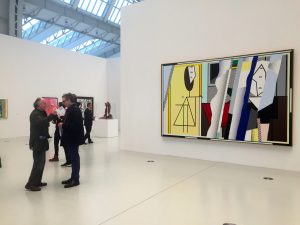
The contribution Photo also shows Picasso, but not the real one. It’s the Hollywood actor John Malkovich, shot by the American photographer Sandro Miller 2014. It is very similar to the “original” by Irving Penn, who portrayed Picasso 1957 in Cannes. So it goes on in the exhibition with over 200 exhibits of, but not directly by Pablo Picasso. Behind every work of art is a story and that makes the show really interesting. The Lichtenstein in the entrance showing his own postmodern adaptation of Picasso’s series L’Atelier. Warhol plays in his series “Heads” strongly with the reproducibility of images. The strong Closeness in his series of works to Picasso’s “Tete” is a bit confusing. Maurizio Cattelan in contrast, slips to better market themselves in the role of Picasso; he plays with Picasso. Black bars, reflections divide by the glass ‘the original’ Picasso’s “Guernica” in Robert Longo, mural Guernica Redacted. Longo created his work especially for the exhibition. Guernica is one of Picasso’s most famous images. He argues the subject with the effects of World War 2 in the small town of Guernica.
“Genius” is written with furniture in the picture. Sean Landers usese different designs of Picasso. Whether he remains himself, or the Spanish champions, called genius is up to the viewer. Picasso himself, amongst others gigantic models such as Velasquez, Rembrandt, Cranach processed. He felt himself in any case as great person, an excellent artist. So he made in his lifetime for a fair presentation of himself, by himself, by organizing impressive photos by Irving Penn, Villiers or Bresson. He would certainly have liked the exhibition, as it shows a unique propagandistic picture of the artist of the century, through all his creative periods, from pink to blue.
“It’s an anniversary exhibition for fun, and enjoying art,” said the director of the Deichtorhalls Dirk Luckow. On November 9th 89, 25 years ago, the former flower halls, opposite the central train station, opened its doors to the international art. Between 1911 and 1914, the Deichtorhalls were built on the site of the former “Berlin station”, the Hamburg counterpart of the “Hamburger Station” in Berlin, as the market halls. Until 1984, it then served first as vegetable- and later as flower- halls. The restauration of the historic buildings were a gift of the founder Kurt A. Körber to the Hanseatic city. He wanted to build a center for modern art for the Hamburgians. Simultaneously with the opening of the Deichtorhallen in November 89 the Wall fell in Berlin. Kurt A. Körber would certainly be satisfied with the results of his efforts.
The exhibition runs from 1st April to 12th July 2015. Deichtorhallen
Tags: Picasso without Picasso


















